


THE REGENCY OF GEORGE, PRINCE OF
WALES 1811 -
xxxxxGeorge III’s eldest son, George, Prince of Wales, had rebelled against his father’s authority from an early age. By his twenties he was heavily in debt through gambling and his excessive life style. A drunkard and a womaniser, he also angered his father by supporting the Whigs, his political opponents. He married Caroline of Brunswick in 1795 in the hope that parliament would pay off his debts, but after the birth of their daughter, the marriage broke up. In January 1811, when the king was no longer fit enough to rule, George became Prince Regent, but he remained unpopular throughout the country. At a time of economic and social depression, there was anger over the way he treated his wife, his own extravagant living, and the vast sums of money spent on ambitious architectural schemes. Amid a number of protests, an attempt was made on his life in January 1817. As we shall see, he came to the throne as George IV following the death of his father in 1820.
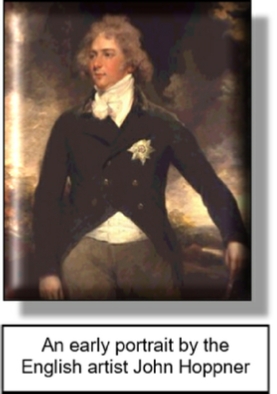 xxxxxBy 1810 it had become abundantly clear that George III
was no longer fit to rule. As we have seen, he had suffered a number
of mental breakdowns throughout his reign -
xxxxxBy 1810 it had become abundantly clear that George III
was no longer fit to rule. As we have seen, he had suffered a number
of mental breakdowns throughout his reign -
xxxxxThe young prince had
rebelled against his father’s strict upbringing in his teens, and
perhaps not without some reason. However, his rebellion was, to say
the least, over the top. At the age of 18 he was spending some
£10,000 a year on clothes alone, and he was deeply in debt by his
early twenties. In 1795 these debts had risen to £650,000, the
result, for the most part, of lavish entertaining, impulsive
gambling, and exorbitantly expensive architectural schemes in
faddish new styles. A perfect butt for the cartoonist and satirist,
he quickly became a man of avant-
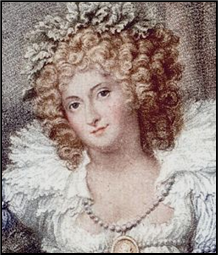 xxxxxAnd, as one would expect, this constant pursuit of
pleasure included a string of mistresses, a not uncommon indulgence
for the aristocracy of his time. At the age of eighteen he was in a
relationship with a Mrs Perdita Robinson, a married actress, and
this was followed by a liaison with Lady Melbourne. His longest and
most controversial attachment was to a catholic widow named Mrs
Maria Fitzherbert, from whom he borrowed large sums of money. It was
said that because she had refused to be his mistress, he had
secretly married her in December 1785. If such were the case then
the marriage was null and void on two counts: he did not have his
father’s permission -
xxxxxAnd, as one would expect, this constant pursuit of
pleasure included a string of mistresses, a not uncommon indulgence
for the aristocracy of his time. At the age of eighteen he was in a
relationship with a Mrs Perdita Robinson, a married actress, and
this was followed by a liaison with Lady Melbourne. His longest and
most controversial attachment was to a catholic widow named Mrs
Maria Fitzherbert, from whom he borrowed large sums of money. It was
said that because she had refused to be his mistress, he had
secretly married her in December 1785. If such were the case then
the marriage was null and void on two counts: he did not have his
father’s permission -
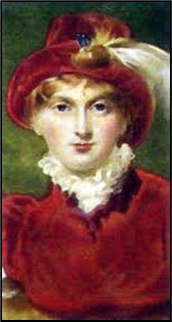 xxxxxAnother woman in his life, but not for long, was his
wife and cousin Caroline Brunswick (illustrated). He reluctantly agreed to marry her in 1795 in the
belief that Parliament would then pay off his debts. He was
therefore furious when more than half his marriage settlement,
together with his income from the Duchy of Cornwall, was set aside
for that purpose, leaving him worse off than when he was a bachelor!
Soon after the birth of their daughter, Princess Charlotte, the
couple lived apart. He managed to prevent her from claiming official
royal privileges, but his efforts to divorce her, which required the
consent of a hostile parliament, ended in failure, despite her own
infidelity. Needless to say his treatment towards his wife won her
much public support, and added further to the widespread dislike of
the Prince Regent. And, as we shall see, this estrangement was to be
the cause of a public scandal when George came to the throne in
1820.
xxxxxAnother woman in his life, but not for long, was his
wife and cousin Caroline Brunswick (illustrated). He reluctantly agreed to marry her in 1795 in the
belief that Parliament would then pay off his debts. He was
therefore furious when more than half his marriage settlement,
together with his income from the Duchy of Cornwall, was set aside
for that purpose, leaving him worse off than when he was a bachelor!
Soon after the birth of their daughter, Princess Charlotte, the
couple lived apart. He managed to prevent her from claiming official
royal privileges, but his efforts to divorce her, which required the
consent of a hostile parliament, ended in failure, despite her own
infidelity. Needless to say his treatment towards his wife won her
much public support, and added further to the widespread dislike of
the Prince Regent. And, as we shall see, this estrangement was to be
the cause of a public scandal when George came to the throne in
1820.
xxxxxIn the matter of politics, the young George greatly angered and embarrassed his father by supporting his opponents. Whilst the king favoured Tory ministers, George cultivated a friendship with the Whigs, cavorting with the likes of Charles Fox and Richard Sheridan, and advocating such measures as Catholic Emancipation and parliamentary reform. Once in power, however, he became an ardent Tory, and discarded such progressive policies. However, this did not stop him opposing some measures put forward by the ministry of Lord Liverpool. Furthermore his royal duties were reluctantly and often tardily carried out. He seldom allowed the demands of state to impinge upon his pleasurable activities.
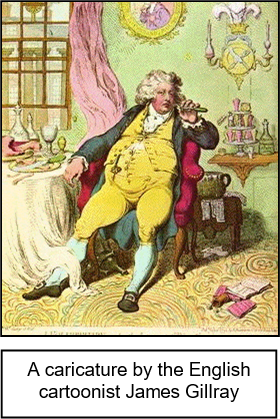 xxxxxAnd, as we have seen, his period as Regent was marked by
an extensive building programme, carried out in the main by his
friend, the London architect John Nash, much of it in the classical
“Regency Style”. This ambitious programme included the development
of Regents Park and its environs, and the building of the exotic
Royal Pavilion at Brighton. Such projects have since become national
treasures, but at the time of their building their enormous cost was
seen against the period of severe economic depression which followed
the ending of the Napoleonic Wars. The need was for tax cuts, and a
reduction in public expenditure, not extravagant architectural
ventures for the well-
xxxxxAnd, as we have seen, his period as Regent was marked by
an extensive building programme, carried out in the main by his
friend, the London architect John Nash, much of it in the classical
“Regency Style”. This ambitious programme included the development
of Regents Park and its environs, and the building of the exotic
Royal Pavilion at Brighton. Such projects have since become national
treasures, but at the time of their building their enormous cost was
seen against the period of severe economic depression which followed
the ending of the Napoleonic Wars. The need was for tax cuts, and a
reduction in public expenditure, not extravagant architectural
ventures for the well-
xxxxxIn January 1820 George III died at Windsor Castle, after a reign of almost 60 years, and the Prince Regent came to the throne as George IV. Extremely overweight and in poor health, it was not long before he himself was showing the first signs of insanity. As we shall see, his reign was never popular and very few mourned his passing in 1830.
xxxxxIncidentally, when the architect John Nash redeveloped the Royal Pavilion in Brighton, an underground passage was dug to link the Prince’s pleasure palace with the nearby home of his “wife”
Mrs Maria Fitzherbert. ……
xxxxx…… It could well be assumed that the nursery rhyme Georgie Porgie was directed at the Prince Regent. He was certainly fond of his “pudding and pie” and, in his time, he “kissed a few girls and made them cry”! In fact, however, the rhyme dates from the Stuart era, and almost certainly refers to the handsome George Villiers, lst Duke of Buckingham. He was a favourite of both James I and Charles I, and his notorious love affair with Anne of Austria, the Queen of France, is featured in Alexandre Dumas’ The Three Musketeers. ……
xxxxx…… We are told that when George died, the loose change found in the pockets of his hundreds of suits amounted to close on £10,000! A little hard to believe! ……
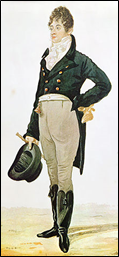
xxxxx……
Numbered among the Prince Regent’s inner circle of friends was the
English dandy George Bryan Brummell (1778-
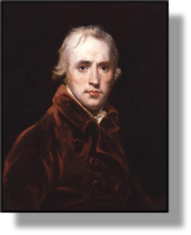 xxxxxThe artist John Hoppner (1758-
xxxxxThe artist John Hoppner (1758-
xxxxxIllustrated here are the
Austrian composer Franz Joseph Haydn, the
Anglo-
Acknowledgements
Prince of Wales:
by the English portrait painter John Hoppner (1758-
Including:
John Hoppner

G3c-



